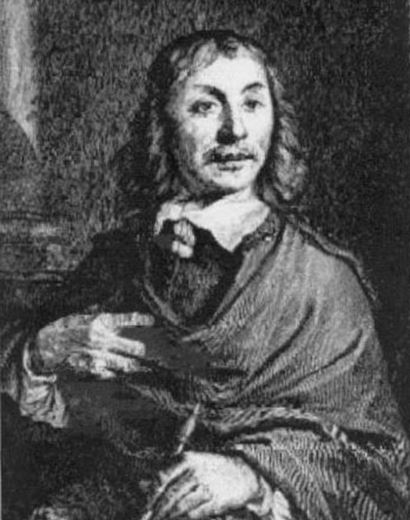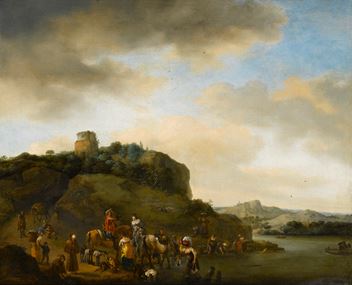
ouwerman Philips
(Haarlem 1619 - Haarlem 1668)
 Biography
Biography Landscape with a Hawking Party Stopped by a River
Biography
Wouwerman was Dutch painter and draughtsman. He was the eldest son of the painter Paulus [Pauwels] Joostens Wouwerman of Alkmaar (d 28 Sept 1642), whose two other sons, Pieter Wouwerman (1623–82) and Johannes Wouwerman (1629–66), also became painters. Philips probably received his first painting lessons from his father, none of whose work has been identified. According to Cornelis de Bie, Wouwerman was next apprenticed to Frans Hals, although no trace of Hals’s influence is discernible in Wouwerman’s work. Wouwerman is also reputed to have spent several weeks in 1638 or 1639 working in Hamburg in the studio of the German history painter Evert Decker (d 1647). While in Hamburg, he married Annetje Pietersz. van Broeckhof. On 4 September 1640 Wouwerman joined the Guild of St Luke in Haarlem, in which in 1646 he held the office of vinder (agent or ‘finder’). Given the many southern elements in his landscapes, it has repeatedly been suggested that Wouwerman must have travelled to France or Italy, but there is no documentary evidence that he left his native Haarlem for more than short periods. During his lifetime he must have attained a certain degree of prosperity, as demonstrated by the relatively large sums inherited by each of his seven children after his wife’s death in 1670. However, there is no confirmation for Houbraken’s statement that Wouwerman’s daughter Ludovica took with her a dowry of 20,000 guilders when she married the painter Hendrik de Fromantiou (1633/4–after 1694) in 1672.
Wouwerman was undoubtedly the most accomplished and successful 17th-century Dutch painter of horses, which were included in his many small cabinet pictures depicting battle scenes, hunting scenes, army camps, smithies and stables. That he was a more versatile painter, however, is shown by his sensitively executed silvery-grey landscapes, his genre scenes and his few, original religious and mythological pictures. He was also exceptionally productive: although he lived to be only 48 years old, more than 1000 paintings bear his name, but some of these should be attributed to his brothers Pieter and Johannes. Only a small number of drawings by Philips are known.
In spite of Wouwerman’s extensive oeuvre, it is difficult to establish a chronology, since only a comparatively small number of his paintings are dated. The style of his signature enables pictures to be dated only within wide limits: a monogram composed of p, h and w was used only before 1646, after which he used a monogram composed of phils and w. His earliest dated work, depicting a Military Encampment (1639; sold London, Christie’s, 10 Oct 1972, lot 13), is of minor quality, but his talents developed rapidly in the 1640s. During that period the artist was strongly influenced, both in style and subject-matter, by Pieter van Laer, who had returned to Haarlem from Italy in 1638. Houbraken claimed that Wouwerman obtained sketches and studies by van Laer after the latter’s death, and van Laer’s influence is clearly demonstrated in Attack on a Coach (1644; Vaduz, Sammlung Liechtenstein), in which several figures and details are quotations from the older artist’s work. During the mid-1640s most of Wouwerman’s compositions are dominated by a diagonal hill or dune, with a tree as repoussoir and a few rather large figures, usually with horses. Three works dated 1646, a Landscape with Peasants Merrymaking in front of a Cottage (Manchester, City Art Gallery), a Battle Scene (London, National Gallery) and a Landscape with a Resting Horseman (Leipzig, Museum der bildenden Künste), show that Wouwerman gradually developed his own style, while continuing to be inspired by the work of van Laer.
By 1649 Wouwerman’s sombre palette had become more colourful and his compositions increasingly horizontal. At about the same time his pictures began to reflect a growing interest in landscape, and during the first half of the 1650s the artist produced a number of paintings that demonstrate his mastery of the subject. In a Landscape with Horsemen (1652; GB, private collection), painted in silvery tones, the figures and horses have been reduced to rather insignificant staffage. Genre elements continued to play an important role in most of his paintings, however, as can be seen in one of his most successful works of that period, Festive Peasants before a Panorama (1653; Minneapolis, MN, Institute of Art). Perhaps nowhere else in his oeuvre did the artist succeed in producing such a happy synthesis of genre and landscape elements. During the second half of the 1650s Wouwerman produced many fanciful hunting scenes, often with a vaguely Italian setting and brighter local colours; these were particularly sought after in the 18th century and the early 19th, especially in France. Although only a few dated works from the last decade of his life survive, these reveal a tendency towards a more sombre palette and show a slight decline in artistic skill. Van Laer’s influence on Wouwerman’s style had almost disappeared, but his work continued to influence Wouwerman’s choice of subject-matter.
Wouwerman had several pupils, including Nicolaes Ficke (b c. 1620), Jacob Warnars and the Swedish artist Koort Witholt in 1642; Antony de Haen (1640–before 1675) studied with him in 1656. Emanuel Murant (1622–c. 1700), Hendrick Berckman (1629–79), Barend Gael (c. 1630/40–after 1681) and his own two brothers were also pupils. Wouwerman also had many followers. All the important collections created during the 18th and the early 19th century, including those that form the nucleus of the museums in St Petersburg, Dresden and The Hague, contain a large number of his works. Between 1737 and 1759 Jean Moyreau (1690–1762) published 89 engravings after paintings by Wouwerman. From the mid-19th century Wouwerman’s popularity declined, but in the late 20th century there was a revival of interest in his work.
Collections
Wouwerman is represented in the following collections: Rijksmuseum, Amsterdam; Museum Bredius, Netherlands; National Gallery, London; The Royal Collection, London; The Wallace Collection, London; Courtauld Institute of Art, London; Dulwich Picture Gallery, London; Holburne Museum of Art, Bath; Sheffield Galleries & Museums, UK; Royal Museums of Fine Arts, Brussels; The Louvre, Paris; Prado Museum, Madrid; Thyssen-Bornemisza Museum, Madrid; Museum der Bildenden Künste, Leipzig; Kunsthistorisches Museum, Vienna; Liechtenstein Museum, Vienna; Slovak National Gallery, Bratislava; Metropolitan Museum of Art, New York; Frick Collection, New York; Museum of Fine Arts, Boston; Crocker Art Museum, California; Harvard University Art Museums, Massachusetts; Detroit Institute of Arts, Michigan; Fine Arts Museums of San Francisco; Hermitage Museum, Saint Petersburg; Christchurch Art Gallery Te Puna O Waiwhetu, New Zealand; National Gallery of Victoria, Australia, amongst others.










